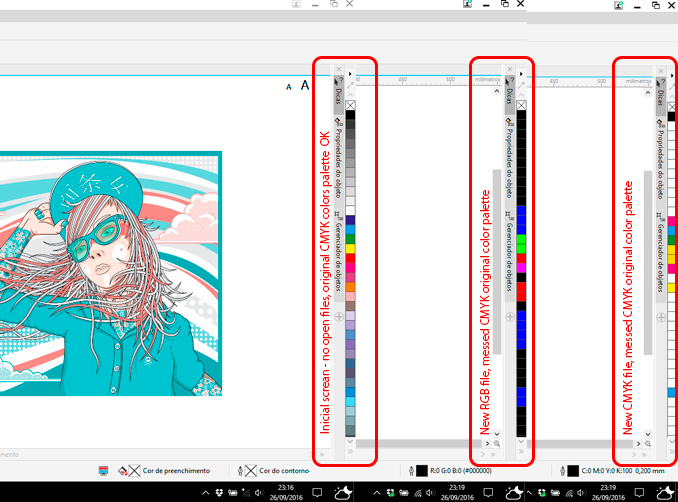Unveiling the Palette Symphony: A Deep Dive into Showing or Hiding Color Palettes in CorelDRAW

Introduction: In the intricate dance of pixels and vectors within CorelDRAW, the ability to show or hide color palettes emerges as a dynamic facet of the design process. These palettes, rich with hues and tones, serve as the painter’s palette for digital artists. In this extensive guide, we embark on a comprehensive exploration of the art and science behind showing or hiding color palettes in CorelDRAW, unraveling techniques, functionalities, and strategies that empower designers to navigate their creative canvases with flexibility and precision.
I. The Role of Color Palettes in CorelDRAW: Color palettes in CorelDRAW act as the color reservoirs from which designers draw inspiration and materials to infuse life into their creations. These palettes are essential not just for selecting colors but also for establishing a cohesive visual language, ensuring consistency, and enhancing the overall design workflow.
A. Visual Consistency:
- Branding Identity: Consistent color usage is paramount for branding identity. CorelDRAW’s color palettes provide a structured framework for maintaining a unified visual language, reinforcing brand aesthetics, and establishing brand recognition across various materials.
- Design Cohesion: Whether working on a single project or across multiple documents, the ability to show or hide color palettes allows designers to control the visual environment, fostering design cohesion and ensuring a harmonious integration of color elements.
B. Efficient Workflow:
- Streamlining Color Selection: The accessibility of color palettes directly impacts the efficiency of the design process. Designers can show or hide palettes strategically, tailoring the workspace to their needs, and accessing essential color resources with a click, reducing the time spent on repetitive tasks.
- Reusability: CorelDRAW’s functionality to show or hide color palettes contributes to the reusability of color schemes. Designers can toggle palettes on and off, adapting the workspace to different stages of the design process and saving valuable screen real estate when needed.
II. Display Options for Color Palettes in CorelDRAW: CorelDRAW offers a versatile set of display options for color palettes, allowing designers to tailor their workspace to match their preferences and design requirements. Understanding these display options is crucial for optimizing the use of color palettes.
A. Palette Docker:
- Docking and Undocking: The Palette Docker in CorelDRAW serves as the central hub for color palettes. Designers can choose to dock or undock this panel based on their workspace preferences. The ability to dock or undock enhances the flexibility of the design environment, adapting to different workflow needs.
- Customizable Docking Positions: CorelDRAW allows designers to position the Palette Docker at different locations on the screen—left, right, top, or bottom. This customization ensures that color palettes are conveniently accessible while allowing designers to optimize their workspace for other design elements.
B. Color Styles Docker:
- Integration with Color Styles: The Color Styles Docker in CorelDRAW seamlessly integrates color palettes with the broader context of design elements. By showing or hiding the Color Styles Docker, designers can access color palettes while working on specific design aspects, ensuring a focused and clutter-free interface.
C. Toolbox Color Palette:
- Quick Access: The Toolbox in CorelDRAW features a compact color palette that provides quick access to essential colors. Designers can show or hide this palette based on their immediate color selection needs, streamlining the design process by offering a simple and efficient color resource.
III. Techniques for Showing or Hiding Color Palettes: Designers can employ various techniques in CorelDRAW to show or hide color palettes based on the specific requirements of their projects, ensuring a dynamic and adaptable design environment.
A. Keyboard Shortcuts:
- Efficiency Boost: CorelDRAW includes keyboard shortcuts that allow designers to show or hide color palettes quickly. Learning and utilizing these shortcuts enhances efficiency, enabling designers to toggle palettes on and off seamlessly without interrupting their creative flow.
B. Workspace Customization:
- Tailoring the Workspace: CorelDRAW’s workspace customization options empower designers to create personalized work environments. By arranging and organizing palettes according to their preferences, designers can show or hide color palettes with a single click, adapting the workspace to different design stages.
C. Multi-Monitor Setup:
- Enhanced Visibility: Designers working with multiple monitors can leverage CorelDRAW’s features to show or hide color palettes on specific screens. This setup enhances visibility, allowing designers to allocate palettes strategically for improved workflow organization.
IV. Advanced Techniques for Palette Management: For designers seeking more advanced control over palette management, CorelDRAW provides features that go beyond basic display options, offering a nuanced approach to showing or hiding color palettes.
A. Palette Dockers in Tabs:
- Tabbed Organization: CorelDRAW allows designers to organize palette dockers into tabs, providing an efficient way to manage multiple palettes. Designers can show or hide specific tabs based on their immediate needs, ensuring that relevant palettes are readily available.
B. Palette Transparency:
- Optimal Workspace Utilization: CorelDRAW’s transparency settings for palette dockers offer designers the ability to control the opacity of palettes. By adjusting transparency, designers can maintain access to color palettes while optimizing workspace utilization, striking a balance between visibility and space efficiency.
V. Challenges and Solutions: In the pursuit of a seamless design experience, designers may encounter challenges related to showing or hiding color palettes. Strategic solutions ensure that these challenges are addressed effectively, optimizing the design process.
A. Limited Screen Real Estate:
- Customizable Docking Positions: When facing constraints in screen real estate, designers can utilize CorelDRAW’s customizable docking positions for palettes. Docking palettes to the sides or top of the screen conserves space while maintaining accessibility.
B. Workflow Adaptation:
- Contextual Workspace Customization: Adapting the workspace to different stages of the design process requires a nuanced approach. CorelDRAW’s contextual workspace customization features enable designers to show or hide palettes based on the immediate context, ensuring a workflow that aligns with the project’s requirements.
VI. Conclusion: In the dynamic canvas of CorelDRAW, the ability to show or hide color palettes emerges as a pivotal skill for designers seeking flexibility, efficiency, and creative control. The software’s array of display options, customization features, and advanced techniques empower designers to curate their workspace, creating an environment that harmonizes with their design process. Beyond mere technical functionalities, showing or hiding color palettes becomes an artistic choice—a strategic decision that aligns with the rhythm of the creative process. In the symphony of design, where each color contributes to the visual melody, CorelDRAW’s versatile tools for palette management are the conductor’s baton, allowing designers to orchestrate their creations with finesse and precision.







